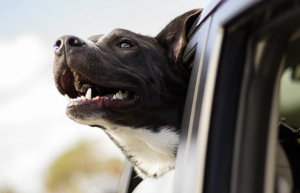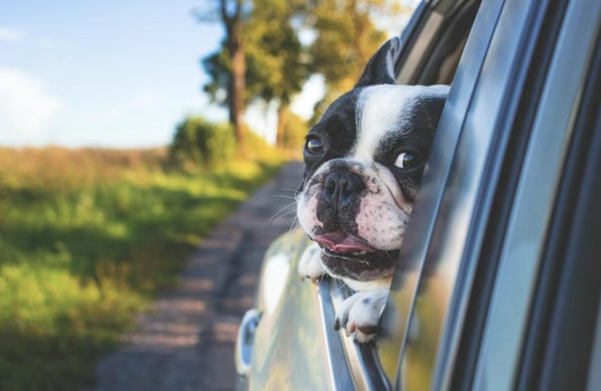It’s a common sight on the road — a car drives by with a “dog head” sticking out of the window. The pup stretches its head outside, tongue hanging long, looking completely carefree, its face filled with pure happiness. Of course, this behavior isn’t exactly safe. The dog may not be secured to the seat, and passing vehicles could potentially bump into it. But safety isn’t today’s main topic. What we really want to explore is this: why do dogs love sticking their heads out of car windows so much?
-
Do dogs stick their heads out to enjoy the view?
Humans love looking at scenery on the road, but dogs aren’t actually that interested in what they see. The reason lies in their vision. A dog’s eyesight is not as vivid as that of humans. Humans have three types of cone cells in their retinas, allowing us to see three primary colors: red, blue, and yellow. Dogs, however, only have two types of cone cells, which means they can only distinguish between blue and yellow. As a result, the world dogs see is much less colorful. Their version of a rainbow isn’t seven shades of red, orange, yellow, green, blue, indigo, and violet—it’s likely just deep blue, light blue, gray, pale yellow, dark yellow, and muted grayish tones. So yes, dogs may want to glance outside the window, but the motivation isn’t as strong as we might think.
-
Do dogs do it to smell new scents?
Now here’s the real reason. For dogs, the smells outside the car are the most irresistible attraction. A dog’s sense of smell is far more powerful than ours. While humans might only notice exhaust fumes or dusty air, dogs can detect layers of scents we can’t even imagine. When the car is moving, air flows rapidly, bringing an endless stream of new smells—it’s like an olfactory feast for them. They can pick up the aroma of someone cooking far away, the scent of fresh grass by the roadside, or even the scent markers left behind by other animals.When a dog sticks its head out of the window, it often opens its mouth and lets its tongue hang out. That’s because dogs have a special scent-detecting organ inside their mouths called the vomeronasal organ (or Jacobson’s organ). It functions like a second nose, analyzing the tiniest scent molecules. Normally, dogs lick their noses to transfer scent particles into their mouth so the vomeronasal organ can process them. But in a moving car, the airflow naturally carries these scents straight in. All the dog has to do is enjoy the ride!

-
Do dogs enjoy the cool breeze?
Absolutely. On hot days, dogs regulate body temperature by panting—opening their mouths and sticking out their tongues. The breeze from a moving car helps with heat exchange, cooling their body and mouth, making them feel more comfortable. Thin-skinned areas like the ears and nose also release heat when the wind blows over them. For the dog, the moving wind feels refreshingly cool.
-
But beware of the risks.
While dogs naturally love sticking their heads out, it does come with safety concerns. First, dogs must be secured properly—either with a dog seatbelt or a travel crate—to prevent them from moving freely inside the car. A sudden fright or burst of excitement could cause them to jump, leading to accidents. Some dogs may even leap out if they spot another dog in heat.Second, it’s best not to let dogs do this in busy city centers. With dense traffic, frequent stops and starts, and cars driving close together, the chance of accidents is much higher.Third, avoid this behavior at high speeds. Strong wind pressure can make dogs uncomfortable and even dangerous, as debris, bugs, or small stones carried by the wind could hit their face or eyes.
-
The ideal scenario.
Picture this: You’re driving along a quiet country road or through a wide suburban street. The car is moving slowly and steadily. The window is slightly open, and your dog is safely secured with a harness or seatbelt. Its head rests at the window, enjoying the wind, the smells, and the gentle change in temperature. Scenery, scents, and comfort—all in one safe package. That’s the most perfect picture of a dog riding in a car.





